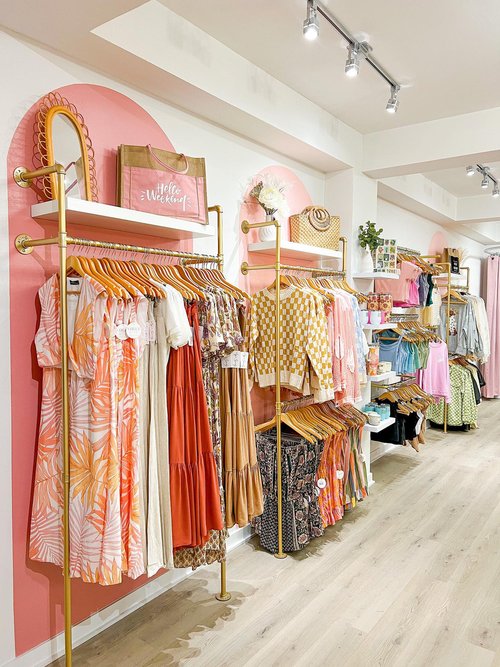Exploring the Evolution and Effect of Clothes on Modern Fashion Trends
The development of apparel has considerably affected modern fashion fads, combining historical precedents with cutting-edge advancements. Legendary figures like Coco Chanel and Yves Saint Laurent changed the garment industry by introducing ideas that prioritize convenience and availability, which remain to reverberate today. Meanwhile, technological strides in areas such as 3D printing and smart fabrics are redefining design possibilities and consumer experiences. Furthermore, the growing emphasis on inclusivity and sustainability is improving sector criteria. As we take into consideration these multifaceted impacts, one must question just how these components jointly redefine style's function in showing and shaping contemporary culture.
Historic Fashion Influencers
In the tapestry of fashion background, specific figures have actually left an indelible mark, shaping the fads and styles that define whole ages. Coco Chanel, a revolutionary developer, redefined ladies's fashion by presenting comfortable, elegant apparel that departed from limiting corsets. Her iconic Chanel match and little black gown have actually ended up being timeless staples in closets worldwide. Likewise, Christian Dior's post-war "New Look" in 1947, with its event of femininity via full skirts and cinched waistlines, marked a go back to opulence and has actually remained to affect designers.
Elsa Schiaparelli is another critical number, renowned for her avant-garde styles that included surrealist art, collaborating with Salvador Dalí to produce wayward items that challenged traditional visual appeals. Her ingenious use color and strong patterns resounds in modern style. Yves Saint Laurent, on the other hand, equalized haute couture with prêt-à-porter collections, bringing runway styles to the masses and establishing a criterion for modern-day ready-to-wear lines.
These visionaries, amongst others, not just revolutionized fashion in their times however likewise established sustaining trends that resonate in today's garment industry, supplying a structure whereupon contemporary designers continue to innovate and build. Their traditions highlight the relevance of creative thinking and daring in fashion's ever-evolving narrative.
Technological Developments in vogue
In the middle of the dynamic landscape of the apparel industry, technological developments stand at the leading edge of development, reshaping exactly how designers create and consumers engage with style. The assimilation of 3D printing has actually changed layout procedures, allowing designers to try out complex structures and lasting products that were formerly unthinkable. This innovation helps with rapid prototyping, reducing waste and expediting manufacturing times.

Smart textiles, installing modern technology into textiles, are also transforming the sector. Innovations like temperature-regulating and self-cleaning textiles provide improved capability and comfort. Wearable innovation, including features like physical fitness monitoring and interaction, adds a new measurement to style, combining visual appeals with functionality.
Social Changes and Design
As technical innovations proceed to improve the apparel industry, social changes are just as significant, redefining design and customer choices. Over the last few years, the surge of social media sites systems has actually sped up the dissemination of worldwide fashion trends, allowing diverse social impacts to merge and exist side-by-side. This electronic interconnectivity has facilitated the fast exchange of concepts, leading to an extra diverse and comprehensive analysis of design that shows the multifaceted nature of modern culture.
Social understanding and gratitude have triggered developers to attract inspiration from a broader range of ethnic and historical contexts, integrating traditional motifs with modern appearances. This blend has resulted in style that resonates with a wider target market, promoting a sense of identification and belonging across various demographics. Furthermore, the increasing need for personalization has driven brand names to provide personalized choices, enabling customers to express originality while showing their social heritage.
Additionally, shifting social values have actually impacted fashion, with inclusivity and variety ending up being main styles. The sector has started to embrace versions and influencers of various type of body, ethnicities, and sex identities, difficult standard charm criteria. This change emphasizes the power of cultural shifts fit the future of fashion, as style comes to be a more genuine expression of collective and individual identity.
Sustainability and Modern Style
While the fashion industry proceeds to evolve, the important for sustainability has become increasingly urgent, influencing modern layout techniques. The surge of slow-moving style, which highlights high quality over quantity, encourages consumers to spend in classic items instead than transient trends.
Furthermore, contemporary design is defined by its development in decreasing waste and advertising circularity. This technique not only minimizes environmental impact however also boosts the social obligation of style homes.

Future Trends in Fashion

Sustainability will certainly remain to be a driving pressure in shaping future style patterns. The sector is progressively adopting green materials and moral production approaches, responding to an expanding consumer need for responsible methods. Innovations such as bio-fabricated products and closed-loop recycling systems are set to redefine exactly how clothing is created and eaten, decreasing ecological impact while keeping style and high quality.
Social shifts, consisting of the surge of inclusivity and diversity, will certainly additionally play a critical duty. As society ends up being extra knowledgeable about social problems, style is expected to end up being a system for resource expression and change. Designers will likely concentrate on developing collections that reflect a wider variety of identifications and experiences, championing depiction and ease of access.
Verdict
The evolution of clothing significantly influences modern-day style trends, where historical influences combine with modern designs. This recurring advancement underscores style's function as a mirror to social worths and technical innovation, recommending a future rich with advancement and inclusivity.
The advancement of garments has actually substantially influenced modern fashion fads, combining historical criteria with sophisticated advancements.In the middle of the dynamic landscape of the style market, technological read more innovations stand at the center of development, reshaping just how designers create and customers engage with style.While the fashion industry proceeds to develop, the vital for sustainability has come to be progressively immediate, affecting modern layout practices. As sustainability comes to be embedded in modern style, it paves the method for a more accountable and conscious style industry.
The advancement of clothing dramatically impacts modern-day fashion patterns, where historical influences combine with contemporary styles.